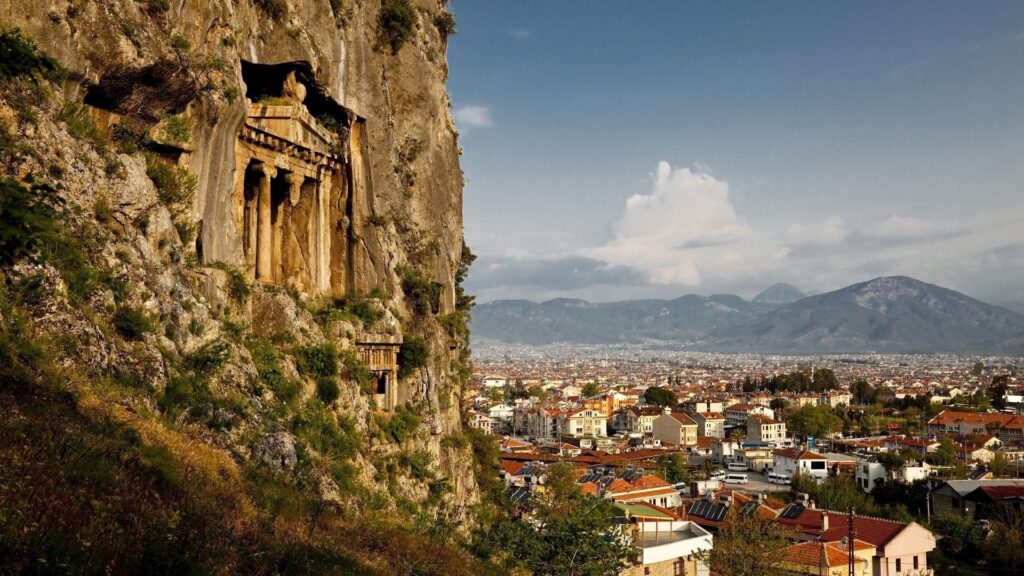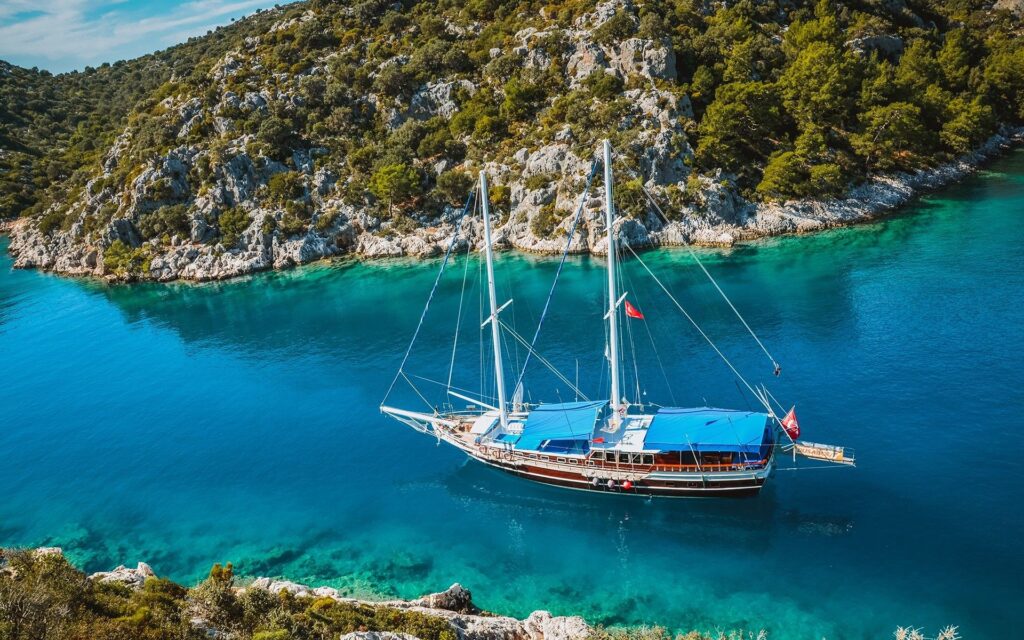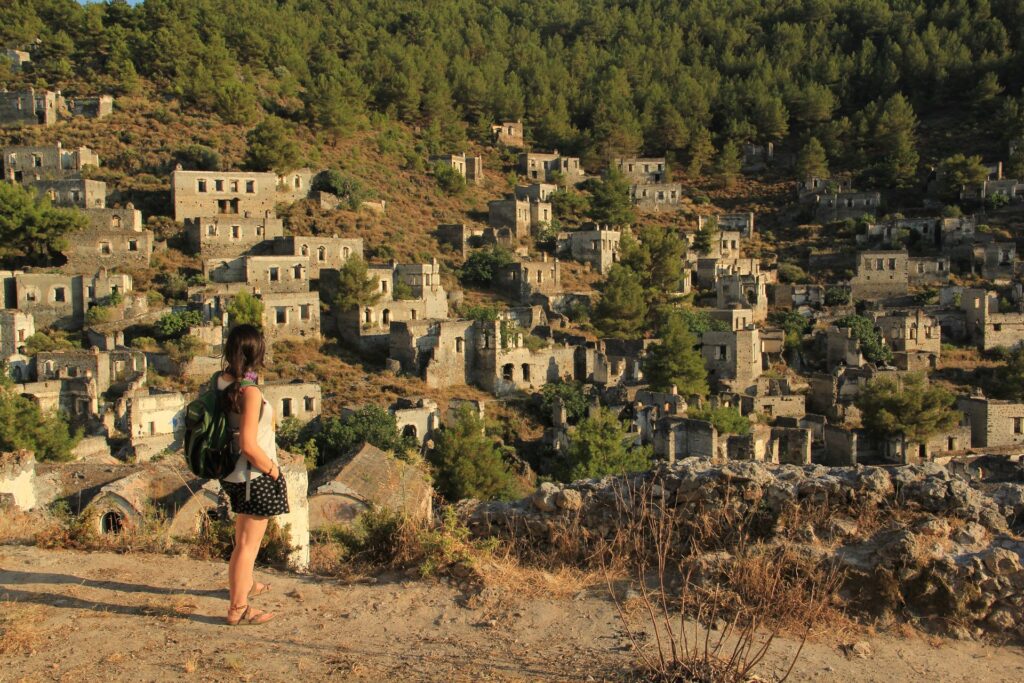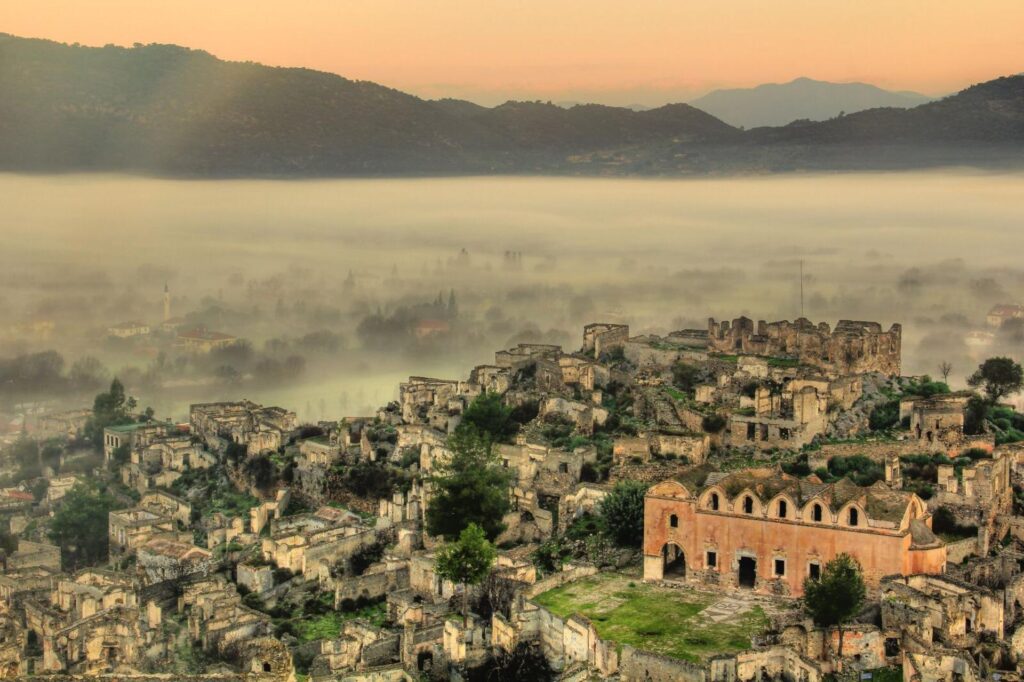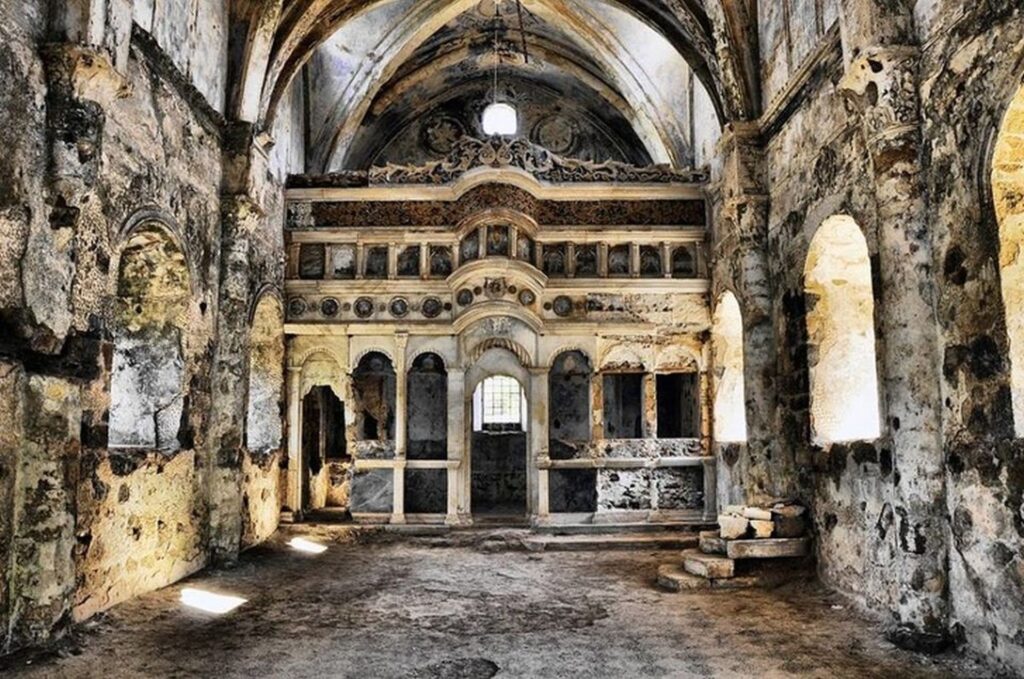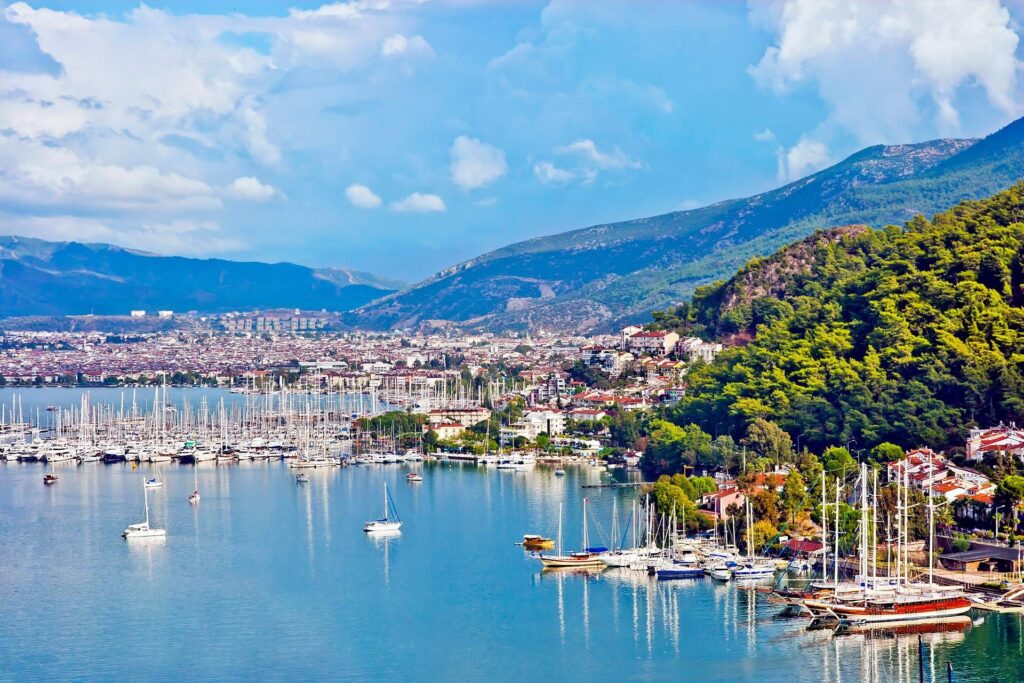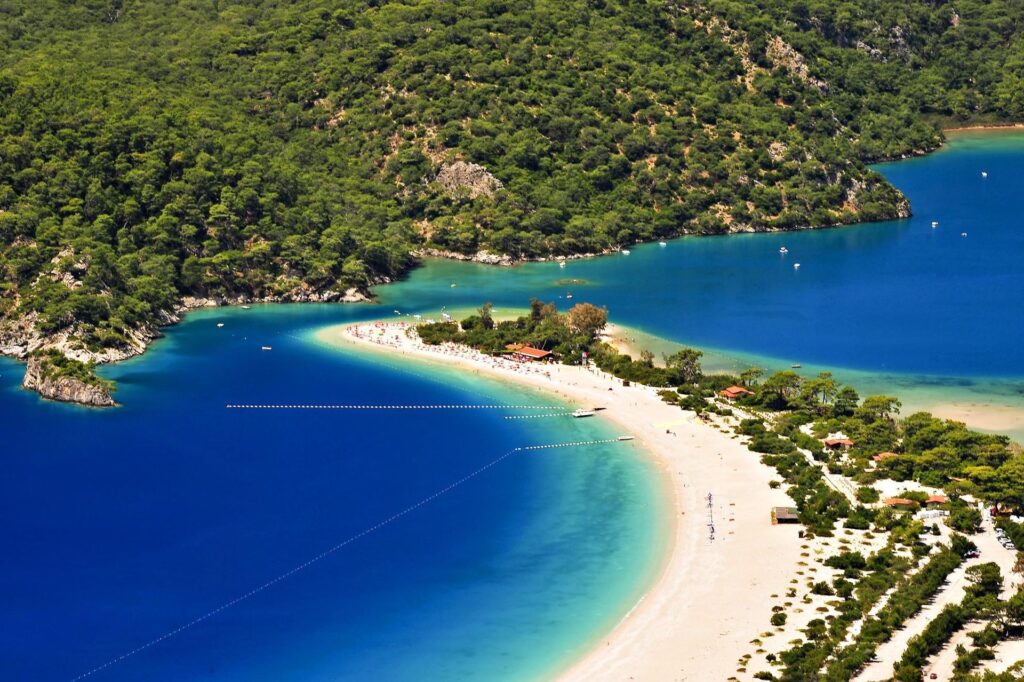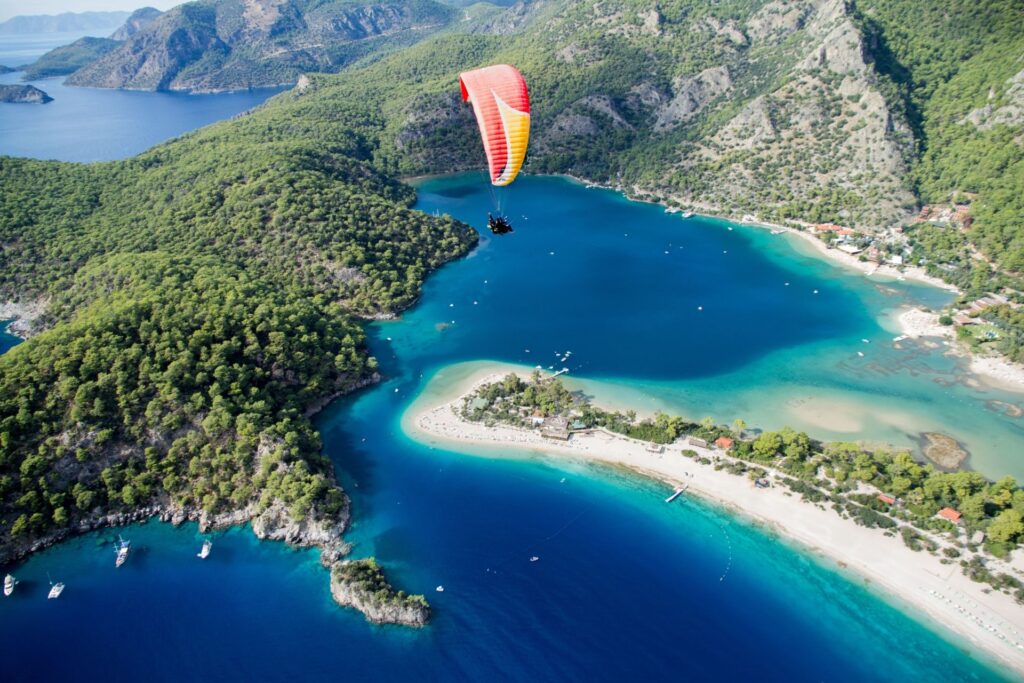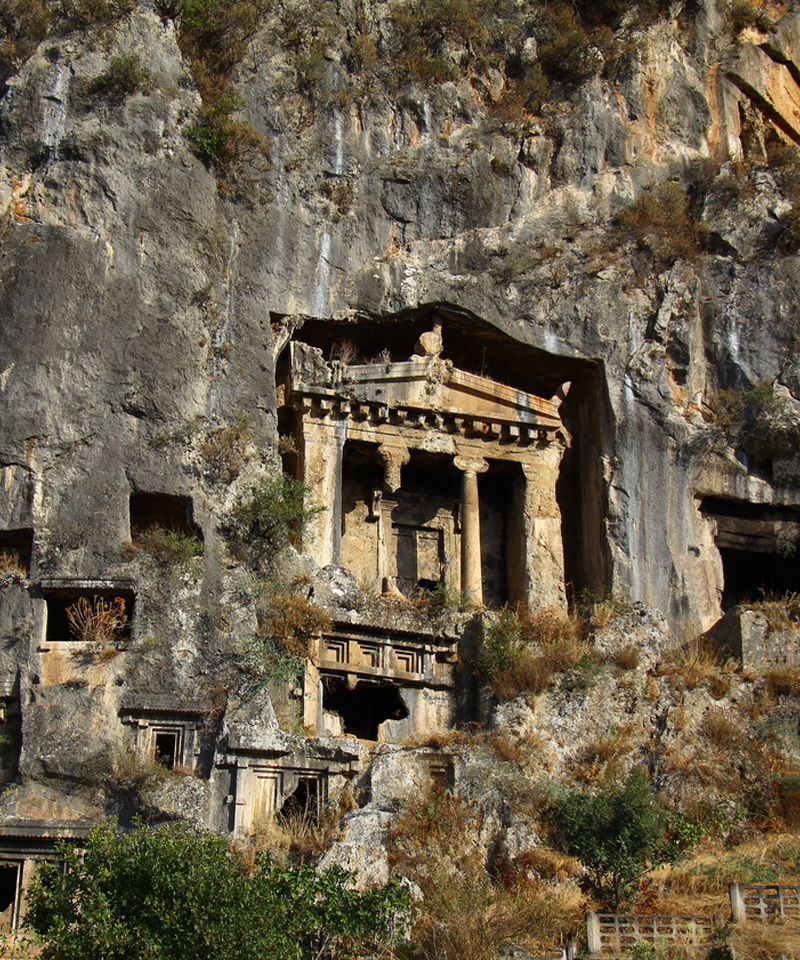Both thrilling and tranquil, this is one place you will return to time and again. Fethiye is the largest town in Muğla, as the westernmost corner of the Mediterranean coasts of Türkiye.
Fethiye, which was a part of the homeland of the ancient Lycian civilization, is a well-known yacht charter stop and is passionately loved by all sea enthusiasts. Enjoy the welcoming, vibrant blue sea against the pine-clad hills around the Gulf of Fethiye, or the Ölüdeniz region with its numerous bays boasting awe-inspiring natural beauty, by setting out with your own boat from the marinas in Fethiye and Göcek.
Destinations in Fethiye
Ölüdeniz
The picturesque lagoon of Ölüdeniz, seem on many posters, is situated where the Med meets the Aegean and is a resort town in Fethiye that has been awarded as one of the world’s best beaches.
Ölüdeni is a protected natural lagoon that the locals call “a haven gifted by God”. Its beach is 3 km long. The colour combinations of different shades of blue and green make swimming and snorkelling most enjoyable. The waters of the Ölüdeniz are warm and calm for 10 months and for this reason it is one of the most famous and regularly visited resorts in the region. It is world renowned for paragliding from the mountain directly behind. Ölüdeniz is 24 km away from Fethiye and separates Belcekız Beach from Kumburnu. Many guest houses, camping places, motels and restaurants are open all year round.
The most important feature of Ölüdeniz is its famous lagoon. The white sand beaches and turquoise waters of Ölüdeniz make for one of the most breath-taking natural spots to see – or swim in! – anywhere in the world. Paragliding from the mountain above over the idyllic lagoon and land on the beach over this stunning sight allows you to see it in all its glory.
On your way to Ölüdeniz form Fethiye, you can visit Kayaköy, without any doubt, you will be moved by their solemnity and quietness among the pastoral view.
Telmessos
Telmessos, modern resort town of Fethiye, is the last large Lykian city on the west, before Caria land begins. Today the modern city developed just over the ancient city, leaving most of the ruins buried underneath the modern town of Fethiye. Nevertheless, The Lykian house and temple type tombs are magnificent, and the Temple of Tomb of king Amyntas is a masterpiece of the Lykian funeral architecture. The ancient theater was also discovered within the city in 1993.
Within the borders of Fethiye, there are many rock-cut tombs carved on a steep rocky slope, 3 of which are temple type and others reflect examples of civil architecture. This tomb, which is one of the three temple types and known as the “King’s Tomb” among the people, has remained relatively intact compared to the other two. Named as Aminthas Tomb (Aminthas Mezarı) due to the inscription “Aminthas son of Hermapias” on the central part of the east ante walls and dated to the 4th century BCE, this Ionic Regular in antis (temple type with two columns between the antes) is the projected form of the front facade of a temple on the rock. The other tombs, which are the symbol of the city and on the same steep slope to the east, are the best examples that give information about the metal and woodworking of the Lycian Region.
Xhantos – Letoon
46 km away from Fethiye, close to the Kınık village, Xanthos is located within the provincial borders of Antalya. It was the largest administrative centre of Lycia in ancient times, and independent until it came under the rule of the Persians in 545 BCE. It was completely burned down approximately a century later. After this fire the city was rebuilt, even had undertaken the task of being the capital of the Lycian Union in the 2nd century BCE. The city later came under the control of the Romans, then under Byzantine rule and remained under Byzantine rule until the Arab raids in the 7th century. This centre, featuring the effects of Lycian traditions, and the Hellenistic and Roman periods, and which has traces of every civilization that inhabited it, was included in the UNESCO World Heritage List in 1988.
4 km from Xanthos, located within the borders of Muğla province, Letoon was the religious centre of Lycia in Antiquity. This sacred are contains the ruins of a monastery, a fountain and a Roman theatre, along with the temples of Leto, Apollo and Artemis. The largest temple dedicated to Leto, the mother of Artemis and Apollo, is the Leto Temple, which is located in the west. It was built in the type of a Peripteros, and is 30.25 by 15.75 m in size. The Apollo temple, built in the Doric style to the east, is less preserved than the Leto temple and is 27.90 by 15.07 m and with smaller dimensions. Located in the middle of both temples and being the smallest temple, the temple of Artemis is 18.20 by 8.70 m in size. Letoon is included in the UNESCO World Heritage List (UNESCO Dünya Mirasları Listesi) along with Xanthos.
Butterfly Valley
Butterfly Valley (Kelebek Vadisi) is one of the most prominent places in Muğla (Fethiye), which has created an isolated structure from the outside world thanks to its natural and protected structure surrounded by the sea and steep cliffs. It is a very surprising effect to see billions of butterflies covering the rocks, the trunks and leaves of the trees, in short, everywhere like a shawl, after a little painstaking climb in the rocky and pine valley, which is declared a 1st degree natural protected area and closed to all kinds of buildings. With a sound or a tiny movement, the butterflies fills the sky, casting a shadow over the valley. The valley in question is home to more than 80 butterfly species.
Near by Kabak Valley (Kabak Koyu) is one of the natural protected areas where many endemic plants are located. It is a bay for yoga and nature lovers, athletes who prefer the camping sites surrounded by nature and wooden bungalow houses. The bay, which is a paradise including the Lycian way walking route, is among the places that should be visited.
The “Ghost Town”: Fethiye’s Kayaköy Village
The images of hundreds of roofless buildings within the natural landscape create wistful sceneries in the aerial photographs of Kayaköy. The region attracts a large number of visitors from both within and outside the country as it houses profound memories. During the difficult periods of World War I, Greeks and Turks lived here, still in harmony, and it was extremely difficult for them to leave their neighbours and the land where they were born and raised. Gradually, the houses were abandoned and the town became a “Ghost Village”, a name it has retained for almost a century now. Without any doubt, you will be moved by their solemnity and quietness among the pastoral view. These houses provide some pensive images. In the garden of abandoned homes, you will devour handfuls of figs. Remember those who planted the fig with respect and compassion, for they might have had to depart before seeing their fruits thrive.
UNESCO designated Kayaköy as a World Friendship and Peace Village. One-third of the ancient village, however, is expected to be developed. There is also the construction of a hotel in addition to the tourism amenities.
Paragliding from the Mountain to the Sea
The scenic sandbank and lagoon of Ölüdeniz lie at the foot of the majestic Mount Babadağ, which soars some 1969 meters above the seaside in Fethiye. Due to the rugged geography of the surrounding area, this pristine bay was only recently discovered in the 60s by a group of adventuresome travellers.
The cove later developed into a beachfront resort area with the arrival of the first hotels in the 90s. Ölüdeniz lagoon operates as a national park today, with paragliding from Babadağ offering a hovering front-row seat to its breathtaking panoramas.
Annually, the International Ölüdeniz Air Games hosts competitive international pilots and their fans for a variety of activities, including hot air ballooning, paragliding, microlight flying, skydiving, and base jumping. If you’re not a fan of flying, you can visit the Babadağ summit by cable car year-round to behold one of the best sunsets imaginable.
Travel tip: Usually shortlisted among the most beautiful long-distance treks in the world, Lycian Way offers a 540-km waymarked trail (rated moderate to difficult), starting from Ölüdeniz and ending at Antalya. One can hike the entire trail in a month, or enjoy shorter, multi-day segments of the whole route. The Butterfly and Kabak Valleys are two neighbouring natural wonders that display a rich variety of endemic plants and wildlife, including a colourful butterfly colony. Here you can indulge in ecological retreats featuring beach huts and glamping domes.
Göcek; Amazing sights and sites where the Mediterranean and the Aegean meet…
Letoon Ancient Theatre
Letoon is located between Kaş and Fethiye, about 4 km south of Xanthos and was an important religious centre of the Lycian region. Letoon was dedicated to the three national deities of Lycia – Leto, Apollo and Artemis. During archaeological studies remains of churches have been found belonging to the early Christian era.
Tlos
Tlos, near Fethiye, was one of the most important religious centres of the Lycian region. According to myth, the hero Bellerophon and his winged horse Pegasus lived here. Tlos dates back to before 2000 B.C. The necropolis (the ancient site of sarcophagi and tombs) is situated on the rocky outcrops of the city acropolis. It contains some of the most elaborate house-type tombs of Lycia. The king-type tomb in the necropolis is dedicated to Bellerophon.
Kayaköy
Kayaköy consists of abandoned Greek-style houses and churches which cover a small mountainside. It dates from the 1700s. After the establishment of the Turkish Republic a population exchange agreement was signed in 1923 between Greece and Türkiye which led to most Greek Christians leaving Kayaköy, also known as Levissi, and being resettled in Greece. The town was left abandoned by the locals and is a haunting reminder of the upheavals forced on local populations in the aftermath of the First World War. It features heavily in the famous novel Birds Without Wings by Louis de Bernieres which is an excellent overview of the 20th Century history of the region. On the edge of the old town there are a mixture of boutique and basic hotels. There is a waymarked path that leads up through the old village to the crest of the hill then winds down to the picturesque resort of Ölüdeniz. The hike takes about 90 minutes.
Telmessos Ancient Theatre
Telmessos was the largest city in ancient Lycia and its remains are scattered around the modern town of Fethiye. The typical Roman type theatre was built in the 2nd century and had a capacity of 5,000 people. Under the authority of the Fethiye Museum Management Chairmanship the site was excavated in 1993. A restoration project was set in place to renovate the theatre. The Fethiye Archaeology Museum displays numerous archaeological finds from the Lycian, Hellenistic, Roman and Ottoman era as well as ethnological art typical for this region.
Xanthos Ancient Theatre
The ancient city of Xanthos is located in the hills above the Eşen Ovası, southeast of Fethiye. It is the site of more than 900 rock tombs and monolithic house tombs.
On the other side of the valley lies Pınara, known as the first place in which beauty contests were held. It gained importance due to a sanctuary that was built and devoted to the goddess Aphrodite.
Gemiler Island
Gemiler Island is covered with Lycian ruins, still containing some mosaics and leftovers of Byzantian churches. This island is also known as St. Nicholas Island and is one of the places Christianity started to spread from.
Saklıkent Canyon
Located only 50 kilometers from the popular holiday district of Fethiye in southwestern Türkiye, Saklıkent Canyon stretches across the middle of Saklıkent National Park. When you enter the national park, you traverse a bridge with the Saklıkent River under your feet. The vast walls of the canyon will envelop you and the sound of the rushing water will enchant you.
Saklıkent is Fethiye’s hidden wonder (Saklıkent means “hidden city”) and is one of the deepest canyons in the world. Saklıkent Canyon is a true testament to nature’s magnificence. The canyon is 300 meters deep and 18 kilometers long. It was formed through the abrasion of rocks by the flowing waters over the course of thousands of years. After April when most of the snow from the Taurus Mountains has melted and passed through the gorge on its way to the Xanthos River, approximately 4 of the 16 km of the canyon are walkable; in the winter, the river swells up and it is impossible to cross the canyon. Summer is the best time to visit since the canyon is refreshingly cool and shady.
The canyon was discovered by a shepherd in the 1980s. There are sections of this extraordinary canyon that are so narrow it is difficult to see the sky from the inside. The pristine water at the bottom is cold even in summer, and there are ample opportunities to get wet! The path will sometimes take you on suspended wooden platforms, and there are seating areas built above the canyon waters. When you have walked through the gorge, you can enjoy a gözleme (Turkish salty crepes) or fresh trout whilst cooling your feet in the canyon’s cold water. River rafting is a popular activity with the gentle rapids aiding you along the course.
